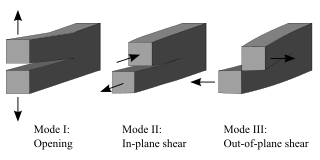This article includes a list of references, but its sources remain unclear because it has insufficient inline citations .(May 2011) (Learn how and when to remove this template message) |
Limit load is the maximum load that a structure can safely carry. It's the load at which the structure is in a state of incipient plastic collapse. As the load on the structure increases, the displacements increases linearly in the elastic range until the load attains the yield value. Beyond this, the load-displacement response becomes non-linear and the plastic or irreversible part of the displacement increases steadily with the applied load. Plasticity spreads throughout the solid and at the limit load, the plastic zone becomes very large and the displacements become unbounded and the component is said to have collapsed.

In physics and materials science, plasticity describes the deformation of a (solid) material undergoing non-reversible changes of shape in response to applied forces. For example, a solid piece of metal being bent or pounded into a new shape displays plasticity as permanent changes occur within the material itself. In engineering, the transition from elastic behavior to plastic behavior is called yield.
Contents
Any load above the limit load will lead to the formation of plastic hinge in the structure. Engineers use limit states to define and check a structure's performance.

In the structural engineering beam theory term, plastic hinge, is used to describe the deformation of a section of a beam where plastic bending occurs. In earthquake engineering plastic hinge is also a type of energy damping device allowing plastic rotation [deformation] of an otherwise rigid column connection.

Engineers, as practitioners of engineering, are professionals who invent, design, analyze, build, and test machines, systems, structures and materials to fulfill objectives and requirements while considering the limitations imposed by practicality, regulation, safety, and cost. The word engineer is derived from the Latin words ingeniare and ingenium ("cleverness"). The foundational qualifications of an engineer typically include a four-year bachelor's degree in an engineering discipline, or in some jurisdictions, a master's degree in an engineering discipline plus four to six years of peer-reviewed professional practice and passage of engineering board examinations.
Bounding Theorems of Plastic-Limit Load Analysis: Plastic limit theorems provide a way to calculate limit loads without having to solve the boundary value problem in continuum mechanics. Finite element analysis provides an alternative way to estimate limit loads. They are:
Plastic limit theorems in continuum mechanics provide two bounds that can be used to determine whether material failure is possible by means of plastic deformation for a given external loading scenario. According to the theorems, to find the range within which the true solution must lie, it is necessary to find both a stress field that balances the external forces and a velocity field or flow pattern that corresponds to those stresses. If the upper and lower bounds provided by the velocity field and stress field coincide, the exact value of the collapse load is determined.

In mathematics, in the field of differential equations, a boundary value problem is a differential equation together with a set of additional constraints, called the boundary conditions. A solution to a boundary value problem is a solution to the differential equation which also satisfies the boundary conditions.
Continuum mechanics is a branch of mechanics that deals with the mechanical behavior of materials modeled as a continuous mass rather than as discrete particles. The French mathematician Augustin-Louis Cauchy was the first to formulate such models in the 19th century.
- The Upper Bound Plastic Collapse Theorem [1]
- The Lower Bound Plastic Collapse Theorem [1]
- The Lower Bound Shakedown Theorem [1]
- The Upper Bound Shakedown Theorem [1]
The Upper Bound Plastic Collapse Theorem states that an upper bound to the collapse loads can be obtained by postulating a collapse mechanism and computing the ratio of its plastic dissipation to the work done by the applied loads.



